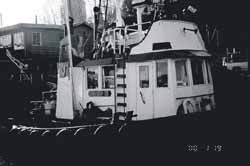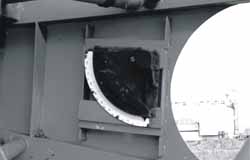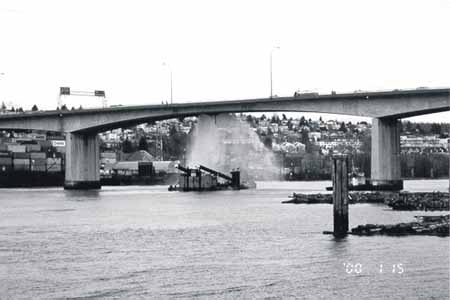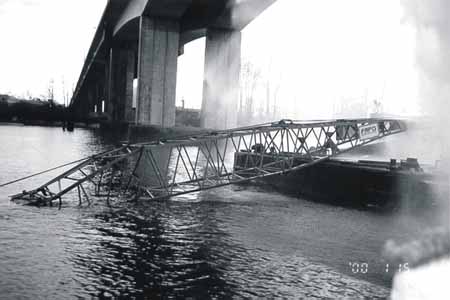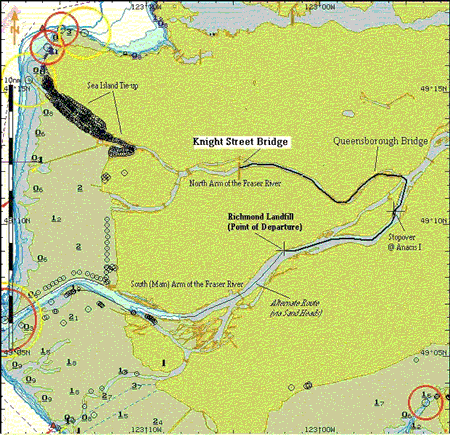Striking of a Bridge
The Tugboat Sea Cap XII and
The Barge T.L. Sharpe
North Arm of the Fraser River
British Columbia
The Transportation Safety Board of Canada (TSB) investigated this occurrence for the purpose of advancing transportation safety. It is not the function of the Board to assign fault or determine civil or criminal liability. This report is not created for use in the context of legal, disciplinary or other proceedings. See Ownership and use of content. Masculine pronouns and position titles may be used to signify all genders to comply with the Canadian Transportation Accident Investigation and Safety Board Act (S.C. 1989, c. 3).
Summary
The boom of a mobile crane transported on the barge T.L. Sharpe, towed by the Sea Cap XII, struck the underside of the Knight Street Bridge at 1345 local time, damaging the bridge and the fixtures secured underneath its deck. The force of the striking caused the boom to bend and the crane to slide off the barge and sink.
Factual information
| Sea Cap XII | T.L. Sharpe | |
| Official number | 348570 | 384121 |
|---|---|---|
| Port of registry | New Westminster, B.C. | New Westminster, B.C. |
| Flag | Canada | Canada |
| Type | Tugboat | Barge |
| Capacity | 51 gross register tons1 | 355.9 gross register tons |
| Length | 13.77 m | 32.0 m |
| Draught | 3.66 m | 0.9 m |
| Built | 1979, Vancouver, B.C. | 1979, North Vancouver, B.C. |
| Propulsion | Diesel, 1,040 brake horsepower, twin screw | None |
| Number of Crew | 2 | Nil |
| Registered Owner | Valley Towing Ltd. | Fraser River Pile & Dredge |
Description of the vessels
Sea Cap XII.
The Sea Cap XII is a small steel tug used mostly in the Fraser River, and occasionally for some light duties in the waters of the Strait of Georgia. It has two propellers in Kort Nozzles and four rudders connected by a bar. At the forward end of a midship deck-house is a control panel with navigation, steering and engine controls; at the after end is a galley.The deck-house, fitted with windows on all four sides, has an almost 360° view from the inside. The door leading to the stern of the tug is partially glassed. There are two funnels astern of the deck-house. As these are offset from the centreline, the crew are able to observe the tow at all times.
The T.L. Sharpe is a rectangular steel barge with a flat deck; it has two side spuds (which are used to secure the barge against the bottom) located about midship and a deck-house at the forward end. On top of the deck-house are machinery for controlling the spuds and two brackets for stowing them.
The barge and the crane, owned by the same company, are used in dredging operations. The barge was adapted to accommodate a mobile crane on its deck. At the forward end of the barge, in front of the deck-house, a steel beam running between two steel posts serves as a cradle for the boom of the crane. Reportedly, the cradle is only used for maintenance of the boom. When the boom is resting in the cradle it is subjected to excessive bending forces and vibration, so the boom remains out of the cradle when the crane is being transported. The practice endorsed by the owners is to stay the boom suspended on its topping wires at some angle above the cradle when the barge is being towed.
The crane on board the barge was a Crawler Manitowoc 4000W. It was fitted with a 39.6 m long boom, pointing forward and suspended by the topping wires. Both the barge and the crane were rigged for towing. The spuds were raised and stowed on top of the deck-house, while the crane with its boom was immobilized and secured to the barge's deck with dedicated wires and eye pads.
The towing company was one of several used by the dredging company on a regular basis to move their equipment, such as barges and scows, between locations on and outside the Fraser River.
The Bridges
Of the several highway and railway bridges that cross the North Arm of the Fraser River, two are fitted with swing spans. The others allow the river traffic to pass under their fixed spans. The clearances under the fixed-span bridges on the route taken by the Sea Cap XII are shown on the Canadian Hydrographic Service (CHS) charts and in the Sailing Directions, and .are also promulgated by the port authority. All these sources were available to the parties involved in the towing operation (see Table 1).
Table 1
| Clearance (in metres) | |||
|---|---|---|---|
| CHS Chart 3491 | North Fraser Harbour Commission sheet | ||
| Bridge | above higher high water, large tide | above local low water | at 12-foot tide2 |
| Queensborough | 22 | 26.0 | 24.4 |
| Knight Street South Branch | 19 | 23.3 | 20.9 |
| Oak Street | 18 | 22.9 | 20.2 |
| Arthur Laing | 19 | 23.3 | 20.6 |
The Knight Street Bridge is a vehicle bridge running north-south that links both sides of the river and Mitchell Island, which divides the river into north and south navigable channels. The section between Vancouver and Mitchell Island is referred to as Knight Street Bridge North, the section between Mitchell Island and Richmond as Knight Street Bridge South. The tug and tow were passing under the Knight Street Bridge South when the boom struck the bridge.
Knight Street Bridge South consists of two separate parallel structures of the same design; one carrying northbound traffic and the other southbound. The main span consists of long cantilever spans from the main piers on each side of the channel, with a drop-in span over the middle of the channel joining the cantilever spans. The drop-in span on each structure is a post-tensioned concrete girder, arched and sitting on two rubber bearings at each end. Each girder is restrained laterally by a single steel guide which is anchored to the cantilevers at each end by four steel bolts.
Each structure has a sectioned deck with a paved surface on top. The southbound structure carries a maintenance walkway under the deck incorporating supports for a water pipe and a gas pipe, as well as electrical lines. The girders and the bridge deck encase the pipes like an inverted U-shaped cage, and are enclosed below by the steel grate of the walkway. The clearances shown in Table 1 are measured directly under the highest point of the arched girders. The bottom of the steel grate is about one metre above that point.
History of the voyage
On 14 January 2000 the barge T.L. Sharpe, with the crane on deck, was moored to a ramp at Richmond Landfill on the north shore of the South Arm of the Fraser River approximately 12 miles upstream from Sand Heads, the river's main estuary. The owners of the barge intended to move the barge to Secret Cove, a future dredging site, located on the north side of the Strait of Georgia, some 38 miles northwest of Sand Heads.
From where the barge was moored, there were two possible routes a tug might follow to reach the Strait of Georgia: downstream through the South Arm via Sand Heads, or upstream to Queensborough and thence down the North Arm of the Fraser River via the Sea Island tie-up (see Appendix A).
An inclinometer was affixed to the crane's arm.
There are no bridges on the first route; the latter is generally narrower and involves passing several bridges and power lines.
The crane operator was instructed by his supervisor to prepare the crane and barge for towing down the south arm of the Fraser River. The preparations included, inter alia, lifting the spuds, stowing them on top of the deck-house and securing the crane and boom.
The supervisor gave no specific instructions as to the angle of the boom, and hence the height of its head. Although an inclinometer was attached to the boom and visible from both the operator's position and from the barge's deck, neither the operator nor his supervisor considered the angle of inclination when the crane was being prepared for the transfer.
In the first week of January, the barge owners requested the T.L. Sharpe and two empty scows from the Sea Island tie-up be delivered to Secret Cove by Monday, 17 January 2000, before noon. The barge owners reported that there was an agreement with the towing company to tow the barge via Sand Heads, directly downstream from the barge's location. In their view, the height of the boom was not a crucial issue, since there were no overhead obstructions on this route. The name of the tug was never mentioned during this or preceding contacts between the companies.
The towing company was of the view that the equipment on the barge could be moved by either route and maintains that the route to follow was left at their discretion. They were of the view that it had been agreed the towing would take place on Sunday, 16 January 2000. The towing company's view - that either route was an option - was reportedly reinforced when the barge owners phoned on Friday, 14 January 2000, to confirm the spuds on the barge were out of the water.
On Saturday, January 15, in the early morning, the tug owners received a call from the dredging company requesting that they remove the T.L. Sharpe from the ramp at Richmond Landfill; another barge was bound for this location and due at 0930. The manager of the towing company contacted the skipper of the Sea Cap XII, at this time engaged in another towing job, and ordered him to proceed to Richmond Landfill to remove the T.L. Sharpe.
Reportedly, because the two scows and the T.L. Sharpe were all to be delivered to the same dredging site, outside of the Fraser River, the towing company planned to dispatch a bigger tug to accomplish the towing of all three units in one haul. The Sea Cap XII, being a small tug, was only assigned to move the T.L. Sharpe to the Sea Island tie-up, where the scows were waiting.
The Sea Cap XII arrived at Richmond Landfill at approximately 1000. The skipper was planning to tow the barge via the North Arm of the Fraser River. From a distance of about 30 m, he visually assessed that the boom would pass under the bridges.
The skipper had available a sheet prepared by the North Fraser Harbour Commission showing bridge clearances referenced to a 12-foot tide. The tug and tow also had to pass through the open spans of two rail bridges that cross the North Arm of the Fraser River.
Neither the skipper nor the deck-hand looked at the inclinometer on the crane's boom, nor did they inquire about the height of the boom's head. In the past, when passing under the bridges, the skipper's main concern was the height of the raised spuds; with the spuds vertical, the skipper could use the marks (in feet) imprinted on them to assess the height of other vertical protrusions. On this particular occasion, as the spuds were stowed, almost horizontal, in their brackets, their height did not cause any concern, and the skipper was not able to use them to estimate the height of the boom.
The Sea Cap XII, with the T.L. Sharpe in tow, left Richmond Landfill at approximately 1020. A few minutes after departure, the owners ordered the Sea Cap XII to stop the trip, tie up the barge temporarily and perform another, short towing job around Annacis Island. At 1055, the skipper secured the barge at Annacis Island, completed the other task and, at 1225, resumed the towing of the T.L. Sharpe.
At approximately 1250, the tug and tow passed under the Queensborough Bridge. Neither the skipper nor the deck-hand observed the top of the boom as it passed under this bridge. Subsequently, with the tow shortened, they passed through the north draw of the CN rail bridge and then lengthened the tow line to approximately 30 m. At approximately 1340, the tug and tow passed the eastern tip of Mitchell Island, some 700 m upstream from the south span of the Knight Street Bridge.
Until this time the trip was routine and the crew of the Sea Cap XII did not anticipate any difficulties or obstacles. The weather was described as clear and cool, with good visibility and a southeasterly wind of approximately 30 knots. The tide was ebbing. Neither the wind nor the surface current were factors in the occurrence. The predicted high water at Sand Heads had been at 1123; at the time of the occurrence the calculated height of tide at Sand Heads was 3.72 m (12.2 feet).
The Knight Street Bridge South seen from the west immediately after the occurrence. The barge T.L. Sharpe with spuds in the cradle and pointing forward is "anchored" under the bridge by the sunken crane astern. Water is escaping from the broken pipe.
At 1345, the tug was passing under the Knight Street Bridge; the skipper had the con while the deck-hand was in the wheel-house with his back to the tow. When the tug was just west of the bridge the crew heard a crashing sound. When they looked back they saw the boom swaying and buckling. The top of the boom was scratching against the underside of the concrete span. Bits of concrete were falling onto the barge, followed by water from an overhead pipe. The skipper reduced propulsion to slacken the pull; however, the barge still had some momentum and the crane, with the top of the boom wedged under the bridge, shifted off the deck and sank astern of the barge.
The skipper immediately called 911 and reported the accident. A few minutes later the Vancouver police called the skipper on his cell phone and advised that all those directly concerned had been notified. The skipper detached the tug from the barge, which was partially submerged and firmly "anchored" under the bridge by the sunken crane. The tug remained in the area for several hours.
Damage
The police stopped all vehicle traffic on the bridge while the authorities inspected the span and assessed the damage to the bridge deck and the two pipes underneath. The water pipe had been split open, allowing the water to spill. The gas pipe did not sustain any significant damage; however, it was moved out of its saddle and several support brackets of the pipe were bent slightly. The anchor bolts for the girder guides on the north end of the southbound drop-in span had been sheared and the lower plate moved about 6 cm to the west.
The crane moved off the barge's deck and sank under the bridge with its boom, bent during the striking, extending above the surface.
The post-occurrence report by the British Columbia Ministry of Transportation and Highways contains a detailed damage assessment. The bridge remained closed to all vehicle traffic for about 48 hours.
The investigation established that the sheave on top of the boom first hit the side of the eastern concrete girder slightly above the highest point of the arch, whereupon it slid under the girder and hit the steel grate and the pipes. As a result of the striking, the boom was bent and twisted and the securing arrangements between the barge and the crane were severed. The crane's machinery was water-damaged as a result of the subsequent sinking.
Vessel Personnel and Operational Procedures
The skipper of the tug possessed a Master, 350 ton, certificate of competency issued in 1972. He had approximately 35 years of towing experience, all in B.C. coastal waters and the Fraser River. He had served as a skipper on the Sea Cap XII since 1980 on a seven-days-on/seven-days-off shift system. The accident happened during the sixth day of the seven-day cycle. On January 15, he left home at approximately 0415 and, prior to towing of the T.L. Sharpe, performed two other towing jobs, both routine and not demanding any extra effort.
The deck-hand on the Sea Cap XII had served for approximately 11 years on various tugs in British Columbia. He had worked for six years with the owners of the Sea Cap XII and, prior to this employment, operated a small tug in Burrard Inlet. He attended one 3-day, basic survival course offered by a local training centre.
Neither the skipper nor the deck-hand had received formal training in teamwork or bridge resource management. The company had not convened any formal meetings or training of their crews, although the location of the company's wharf, in New Westminster, and the nature of the operations (short-range towing) allowed for frequent contacts and exchanges of information among crews and management.
The towing company, owners of the Sea Cap XII, did not establish any written rules or guidelines - directed to the skippers - addressing or outlining the operational procedures including the requirement to determine the barges air draft. Reportedly, the towing tasks are in most cases typical, and the operation of the organization is based on methods and customs developed and adapted over the years.
Occasionally, skippers of the tugs assigned to a particular job expressed their requirements upon arrival at the site, and these were always rectified before the towing started. The skipper of the Sea Cap XII was aware that if he had any requests, including a refusal to start the tow, these would be fully respected by the management.
In a similar occurrence3 on 8 March 1993, the tug4 Ingenika was towing the barge T.L. Sharpe (same owners) with the same model crane aboard, under Cambie Street bridge, False Creek, Vancouver. The raised boom, secured to the barge in a similar arrangement, struck the underside of the road bridge and the crane slid off the barge.
Analysis
It was reasonable for the small Sea Cap XII to follow the inner route. Although spanned by several bridges, the inner route would not require the tug and tow to leave the river, navigate the open waters of the Strait of Georgia, and re-enter the river at Point Grey. As the size and nature of the tow did not seem to present any restrictions, and the tug was handled by an experienced skipper who had transited the river with this and other tows on many occasions, the manager of the towing company did not hesitate to assign the Sea Cap XII to complete this short towing job.
Notwithstanding that the owners believed that the tow would be conducted down the south arm of the river, it could not be determined whether there was a clear agreement between the owners and the towing company over the route to be followed. A clear understanding by the owners and the towing company might have prompted them to more carefully examine all aspects of the transit plan.
The final decision as to the readiness of the tow was left in the hands of the skipper of the Sea Cap XII. He was aware of his responsibility, and that he could refuse to start the tow. However, a lack of written procedures and the absence of a clear understanding between the companies stipulating the essential components of the job, including the route to follow, reduced the overall safety of the operation.
Using the calculated height of tide at Sand Heads (12.2 feet), the clearance under the Knight Street Bridge at the time of striking is calculated to have been 20.84 m, approximately 6 cm (0.2 feet) lower than that given in the North Fraser Harbour Commission sheet. Whatever the exact clearance may have been, it was not noted by any of those involved in the operation; the boom was not positioned with regard to the bridge's clearance, nor was its height checked against the data.
As the tow moved down the North Arm of the Fraser River, there was one final opportunity to note the impending lack of clearance under the Knight Street Bridge. This was the difference in clearances between the Queensborough and Knight Street bridges. The tug and tow passed under the Queensborough Bridge less than one hour before hitting the Knight Street Bridge. The clearance under the Queensborough Bridge is approximately three metres greater than the clearance under the Knight Street Bridge. The boom first contacted the side of the Knight Street Bridge; from this it can be deduced that the top of the boom must have passed within three metres of the underside of the Queensborough Bridge. Such a close pass, if observed from the tug below, would almost certainly have led the crew to reassess the situation. However, neither the skipper nor the deck-hand attended to this aspect of the operation, and so this available clue was lost. The skipper was concentrating on conning the tug, and the deck-hand did not assume that he had a responsibility to observe the boom end and, if necessary, warn the skipper.
The towing company policy and, specifically, the lack of clear rules and job descriptions, allowed the tug crew to apply their own, custom-formed measures when performing their tasks. In most cases their experience and on-the-job training were satisfactory. However, such a system can fail - and lead to an accident - when a not-so-typical task comes along, or when one of those involved fails to examine all aspects of the task. In this instance, the owners of the barge, and the towing company, and the crew of the tug all relied on the others to verify that the barge had sufficient air draft to safely complete the voyage.
Findings
- The end of a crane boom on the barge T.L. Sharpe hit the span of the Knight Street Bridge.
- The crane shifted off the barge's deck and sank under the bridge.
- The impact of the crane damaged the bridge, which was subsequently closed to traffic for two days.
- No one involved in transportation of the crane assessed the height of the boom prior to the towing operation.
- The crew of the tug did not observe the height of the tow while passing under the Queensborough bridge.
- The towing company had not established any written operational procedures to be observed by the tug crews.
- There was no clear understanding among the tug owner, tug operator, and barge owner over which route the tow would take.
Causes and Contributing Factors
The boom of the crane struck the span of the Knight Street Bridge because the air draft of the tow was not ascertained prior to commencing the tow. Contributing to the occurrence was the lack of a clear understanding of the tug owner, tug operator and barge owner of the route the barge was expected to take.
Safety action
As a result of the accident in March 1993, the barge owners initiated standard verbal communication procedures with contracted towing companies. Following this second occurrence, the owners of the barge and crane have initiated steps to develop more-formal written procedures for communicating with towing companies. When a towing order is placed, the dimensions of the tow, including its height, will be explicitly communicated to the towing party.
This report concludes the Transportation Safety Board's investigation into this occurrence. Consequently, the Board authorized the release of this report on .
<a name="Appendix_A" id="Appendix_A"></a>Appendix A - Sketch of the Occurrence Area
[1] Units of measurement in this report conform to International Maritime Organization standards or, where there is no such standard, are expressed in the International System of units.
[2] The clearances given by the North Fraser Harbour Commission are based on Sand Heads datum. These clearance figures are approximately 2 m greater than those shown on the Canadian Hydrographic Service chart, as they are referenced to differing datum.
